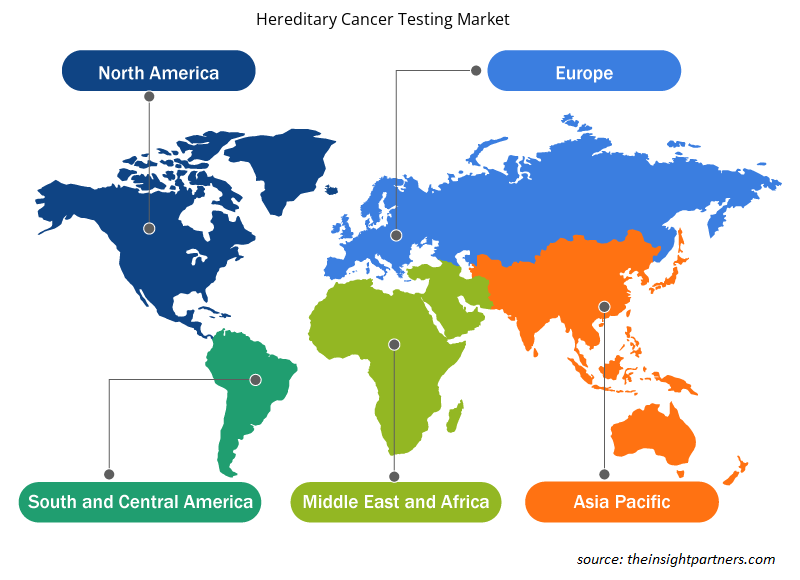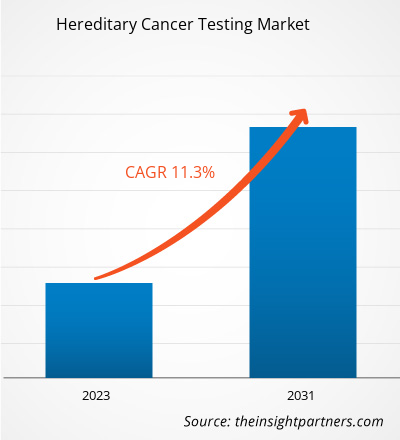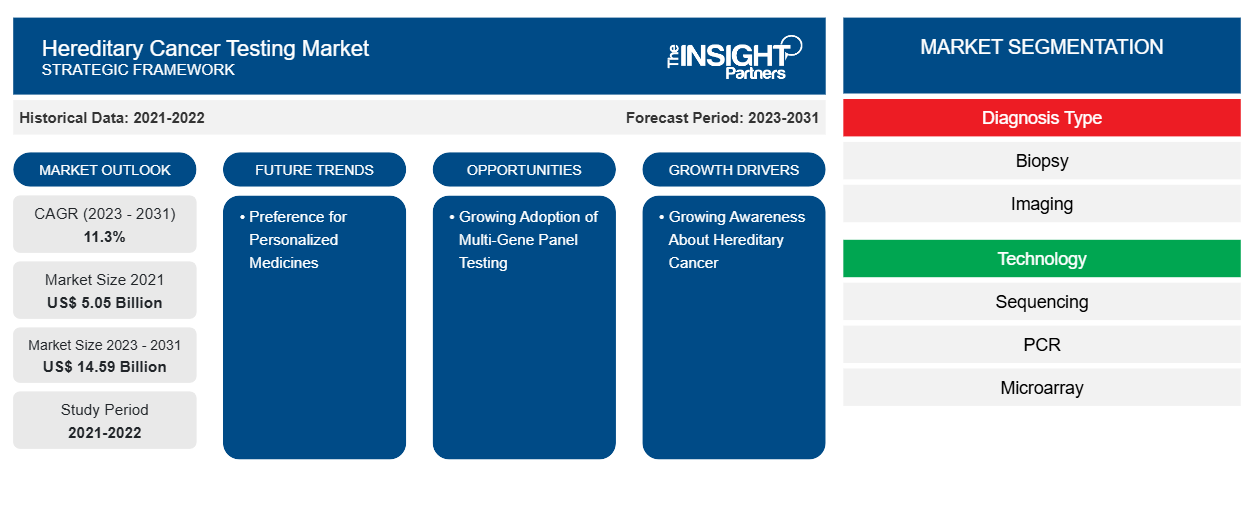Se estimó que el tamaño del mercado de pruebas de cáncer hereditario sería de 5.050 millones de dólares en 2021 y de XX.000 millones de dólares en 2023, y se espera que alcance los 14.590 millones de dólares en 2031; se estima que registrará una CAGR del 11,3% entre 2023 y 2031. La creciente prevalencia del cáncer hereditario y la creciente conciencia sobre el cáncer hereditario son factores impulsores. La preferencia por los medicamentos personalizados probablemente seguirá siendo clave para las tendencias del mercado de pruebas de cáncer hereditario.
Análisis del mercado de pruebas de detección de cáncer hereditario
El cáncer es un trastorno genético causado por variaciones definidas en los genes que rigen el funcionamiento celular, afectando particularmente a su crecimiento y replicación. Las mutaciones genéticas hereditarias causan entre el 5 y el 10 % de todos los cánceres. Los investigadores han relacionado mutaciones en genes específicos con más de 50 síndromes de cáncer hereditario que afectan a individuos que desarrollan ciertos cánceres. Además, entre el 5 y el 10 % de los cánceres de mama están relacionados con los genes mutados heredados de los padres. Las variaciones en los genes BRCA1 y BRCA2 son frecuentes. Las mujeres con una mutación BRCA1 tienen un riesgo de por vida de desarrollar cáncer de mama de aproximadamente el 72 %, mientras que aquellas con la mutación BRCA2 tienen un riesgo de aproximadamente el 69 % de lo mismo.
Descripción general del mercado de pruebas de cáncer hereditario
Asia Pacífico es el mercado de más rápido crecimiento para las pruebas de cáncer hereditario. La región tiene un enorme potencial para los actores del mercado de pruebas de cáncer hereditario debido al apoyo gubernamental en países como Corea del Sur para la concienciación sobre el cáncer y otras iniciativas. La demanda de secuenciación genética en China está creciendo, principalmente debido al aumento de la clase media del país, la población de edad avanzada y el aumento del sistema de atención sanitaria. Según datos de la OMS, el gobierno chino ha implementado el plan "China saludable 2030", que es útil para su población.
Personalice este informe según sus necesidades
Obtendrá personalización en cualquier informe, sin cargo, incluidas partes de este informe o análisis a nivel de país, paquete de datos de Excel, así como también grandes ofertas y descuentos para empresas emergentes y universidades.
-
Obtenga las principales tendencias clave del mercado de este informe.Esta muestra GRATUITA incluirá análisis de datos, desde tendencias del mercado hasta estimaciones y pronósticos.
Factores impulsores y oportunidades del mercado de pruebas de cáncer hereditario
Creciente conciencia sobre el cáncer hereditario
La concienciación sobre las enfermedades hereditarias relacionadas con el cáncer está aumentando gracias a los diversos esfuerzos realizados por el gobierno. En la última década, las comunidades médicas, sanitarias y científicas públicas han invertido en difundir la concienciación sobre las enfermedades hereditarias relacionadas con el cáncer, con especial atención al riesgo de cáncer hereditario, los antecedentes familiares y las pruebas genéticas para detectar la predisposición a padecer cáncer hereditario. Además, los fabricantes se están centrando en adoptar estrategias como el lanzamiento y la aprobación de productos, las inversiones en I+D, la financiación gubernamental y las asociaciones para facilitar el acceso a los pacientes de todo el mundo. Por ejemplo, en abril de 2024, Ambry puso en marcha la colaboración de la Coalición Interorganizacional de Evidencia Clínica sobre Genética del Cáncer (INTERACT) para impulsar las pruebas de cáncer hereditario, con el objetivo de aumentar el acceso a pruebas genéticas especializadas.Ambry Launched the Inter-Organization Cancer Genetics Clinical Evidence Coalition (INTERACT) collaboration to spur hereditary cancer testing, aiming to increase access to specialized genetic testing.
La creciente adopción de pruebas de panel multigenético: una oportunidad
Un panel multigénico elimina la necesidad de realizar múltiples ensayos para diferentes tipos de cáncer o variantes. La variación del número de copias (CNV) es una fuente común de variación genética y está involucrada en muchos trastornos genéticos. También es un componente crítico del diagnóstico de cáncer hereditario.
El Gobierno del Reino Unido y Genomic England han declarado que todos los análisis de CNV se realizarán ahora mediante NGS en lugar de mediante la amplificación de sonda dependiente de ligación múltiple (MLPA). Debido a sus ventajas, todos los procesos de laboratorio se agilizarán y permitirán la detección de todas las variantes de SNV, INDEL y CNV mediante un único flujo de trabajo y una única secuencia de análisis.
Se incrementará la adopción de pruebas de panel multigénico en varios países de América del Norte, Europa y Asia.
Análisis de segmentación del informe de mercado de pruebas de cáncer hereditario
Los segmentos clave que contribuyeron a la derivación del análisis del mercado de pruebas de cáncer hereditario son el tipo de diagnóstico del producto, la tecnología y el usuario final.
- Según el tipo de diagnóstico, el mercado de pruebas de cáncer hereditario se segmenta en biopsia e imágenes. El segmento de biopsia tuvo la mayor participación de mercado en 2023. Sin embargo, se prevé que el segmento de imágenes registre la CAGR más alta durante el período de pronóstico.
- Según la tecnología, el mercado de pruebas de cáncer hereditario se segmenta en secuenciación, PCR y microarray. El segmento de secuenciación tuvo la mayor participación de mercado en 2023, y se proyecta que el mismo segmento registre la CAGR más alta durante el período de pronóstico.
- Según el usuario final, el mercado de pruebas de cáncer hereditario se segmenta en centros de diagnóstico, hospitales y clínicas. El segmento hospitalario tuvo la mayor participación de mercado en 2023. Además, se estima que el mismo segmento registrará la CAGR más alta del mercado durante el período de pronóstico.
Análisis de la cuota de mercado de las pruebas de detección del cáncer hereditario por geografía
El alcance geográfico del informe de mercado de pruebas de cáncer hereditario se divide principalmente en cinco regiones: América del Norte, Asia Pacífico, Europa, Medio Oriente y África, y América del Sur / América del Sur y Central.
El mercado de pruebas de cáncer hereditario en América del Norte está segmentado en Estados Unidos, Canadá y México. Estados Unidos tuvo la mayor participación en el mercado de pruebas de cáncer hereditario en América del Norte en 2023. El crecimiento proyectado del mercado de pruebas de cáncer hereditario en América del Norte está impulsado por el creciente número de pacientes con cáncer, el aumento de la financiación gubernamental y la creciente incidencia de enfermedades genéticas entre la población de Estados Unidos y Canadá durante los últimos años. El gobierno también tomó iniciativas para crear conciencia sobre el cáncer entre la población. Por ejemplo, la Sociedad Estadounidense de Oncología Clínica (ASCO) ofrece un curso sobre concienciación sobre el cáncer para difundir un conocimiento completo y esencial de esta afección, incluida la genética del cáncer hereditario.
Perspectivas regionales del mercado de pruebas de cáncer hereditario
Los analistas de Insight Partners han explicado detalladamente las tendencias y los factores regionales que influyen en el mercado de pruebas de cáncer hereditario durante el período de pronóstico. Esta sección también analiza los segmentos y la geografía del mercado de pruebas de cáncer hereditario en América del Norte, Europa, Asia Pacífico, Oriente Medio y África, y América del Sur y Central.

- Obtenga datos regionales específicos para el mercado de pruebas de cáncer hereditario
Alcance del informe de mercado sobre pruebas de cáncer hereditario
| Atributo del informe | Detalles |
|---|---|
| Tamaño del mercado en 2021 | 5.050 millones de dólares estadounidenses |
| Tamaño del mercado en 2031 | US$ 14,59 mil millones |
| CAGR global (2023 - 2031) | 11,3% |
| Datos históricos | 2021-2022 |
| Período de pronóstico | 2023-2031 |
| Segmentos cubiertos |
Por tipo de diagnóstico
|
| Regiones y países cubiertos |
América del norte
|
| Líderes del mercado y perfiles de empresas clave |
|
Densidad de actores del mercado de pruebas de cáncer hereditario: comprensión de su impacto en la dinámica empresarial
El mercado de pruebas de detección de cáncer hereditario está creciendo rápidamente, impulsado por la creciente demanda de los usuarios finales debido a factores como la evolución de las preferencias de los consumidores, los avances tecnológicos y una mayor conciencia de los beneficios del producto. A medida que aumenta la demanda, las empresas amplían sus ofertas, innovan para satisfacer las necesidades de los consumidores y aprovechan las tendencias emergentes, lo que impulsa aún más el crecimiento del mercado.
La densidad de actores del mercado se refiere a la distribución de las empresas o firmas que operan dentro de un mercado o industria en particular. Indica cuántos competidores (actores del mercado) están presentes en un espacio de mercado determinado en relación con su tamaño o valor total de mercado.
Las principales empresas que operan en el mercado de pruebas de cáncer hereditario son:
- Compañía hologica inc.
- Philips NV, la línea Koninklijke
- Quest Diagnostics Incorporated
- Genética Myriad, Inc.
- Genética del cáncer Inc.
- Corporación Invitae
Descargo de responsabilidad : Las empresas enumeradas anteriormente no están clasificadas en ningún orden particular.

- Obtenga una descripción general de los principales actores clave del mercado de pruebas de cáncer hereditario
Noticias y desarrollos recientes del mercado de pruebas de cáncer hereditario
El mercado de pruebas de detección de cáncer hereditario se evalúa mediante la recopilación de datos cualitativos y cuantitativos de investigaciones primarias y secundarias, que incluyen publicaciones corporativas importantes, datos de asociaciones y bases de datos. A continuación, se incluye una lista de los avances en el mercado de pruebas de detección de cáncer hereditario:
- Exact Sciences Corp. anunció el lanzamiento de la prueba de cáncer hereditario Riskguard en los Estados Unidos. Esta prueba proporciona un informe individualizado del paciente que incluye riesgos genéticos y familiares utilizando una simple muestra de sangre o saliva para 10 cánceres comunes, incluidos el cáncer colorrectal , endometrial, gástrico, pancreático, de mama, de próstata, de piel, de ovario, de riñón y endocrino. (Exact Sciences Corp / Nota de prensa, febrero de 2024)
- Devyser anunció el lanzamiento de dos nuevos productos, Devyser LynchFAP y Devyser BRCA PALB2. Estos kits ofrecen un análisis eficiente, específico y confiable de los genes asociados con un mayor riesgo de cáncer. Devyser LynchFAP proporciona una solución integral para analizar PMS2 y otros 9 genes asociados con síndromes de cáncer colorrectal hereditario (Fuente: Devyser, comunicado de prensa, junio de 2023)
Informe de mercado sobre pruebas de cáncer hereditario: cobertura y resultados
El informe “Tamaño y pronóstico del mercado de pruebas de cáncer hereditario (2021-2031)” proporciona un análisis detallado del mercado que cubre las siguientes áreas:
- Tamaño del mercado y pronóstico a nivel global, regional y nacional para todos los segmentos clave del mercado cubiertos bajo el alcance
- Dinámica del mercado, como impulsores, restricciones y oportunidades clave
- Principales tendencias futuras
- Análisis detallado de las cinco fuerzas de Porter y PEST y FODA
- Análisis del mercado global y regional que cubre las tendencias clave del mercado, los principales actores, las regulaciones y los desarrollos recientes del mercado.
- Análisis del panorama de la industria y de la competencia que abarca la concentración del mercado, el análisis de mapas de calor, los actores destacados y los desarrollos recientes
- Perfiles detallados de empresas
- Análisis histórico (2 años), año base, pronóstico (7 años) con CAGR
- Análisis PEST y FODA
- Tamaño del mercado, valor/volumen: global, regional y nacional
- Industria y panorama competitivo
- Conjunto de datos de Excel
Informes recientes
Informes relacionados
Testimonios
Razón para comprar
- Toma de decisiones informada
- Comprensión de la dinámica del mercado
- Análisis competitivo
- Información sobre clientes
- Pronósticos del mercado
- Mitigación de riesgos
- Planificación estratégica
- Justificación de la inversión
- Identificación de mercados emergentes
- Mejora de las estrategias de marketing
- Impulso de la eficiencia operativa
- Alineación con las tendencias regulatorias























 Obtenga una muestra gratuita para - Mercado de pruebas de cáncer hereditario
Obtenga una muestra gratuita para - Mercado de pruebas de cáncer hereditario